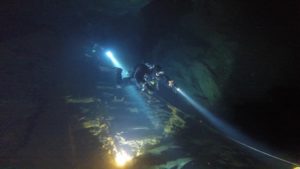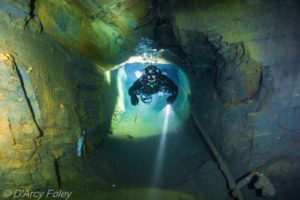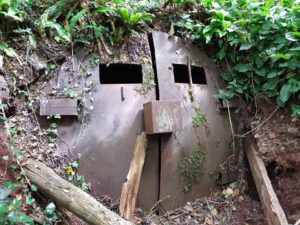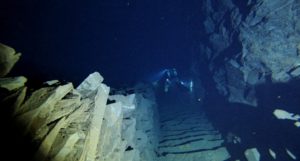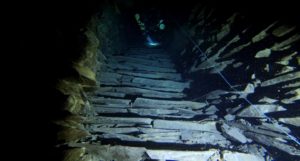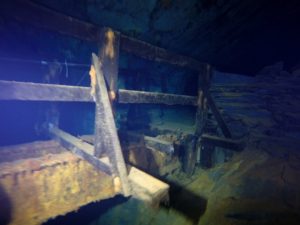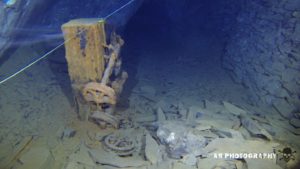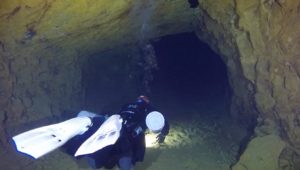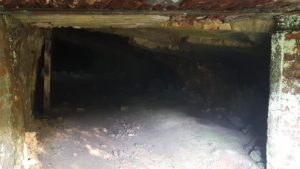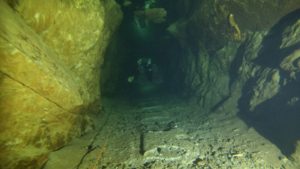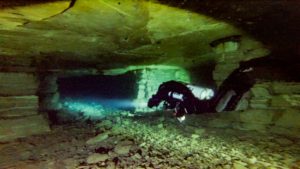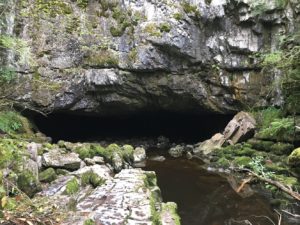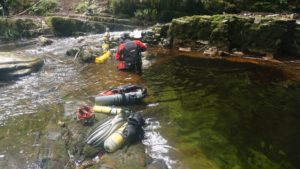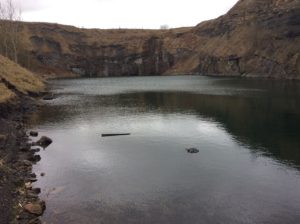This page lists some of the more popular mine and cave dive sites in the UK with a little basic information to give you a feel for what is out there. UKMC members can gain access to a wealth of additional information for these sites and more, including location maps, access agreements, dive maps, surveys, photographs and videos.
Aberlas slate mine, Clwyd, North Wales
Aberlas is the spiritual home and jewel in the crown of the UKMC.
Discovered following a chance meeting with the landowner during a dive at neighbouring Cambrian slate mine, the UKMC founders began exploration in 2013.
Some eight months later the end of the shallow section was reached at 588m and eventually a link between Aberlas and Cambrian was confirmed (no longer accessible).
The mine is split over two distinct levels – the shallow level averages 8m depth and the deeper around 20m. The two levels are joined at the dive base entrance as well as the “Stairway to Heaven” around 225m in.
The two levels feature long railed haulage ways that allow travel between the many large chambers. A large part of the mine has been lined by UKMC divers with main lines down the haulage ways requiring a jump to the lines in the individual chambers.
Bream & Noxon Park iron mines, Gloucestershire
There are a number of flooded iron mines in the Forest of Dean area, the most well known being Bream and Noxon Park (sometimes called ‘The ‘Crater’) which are located almost next door to each other close to Coleford in Gloucestershire.
Permission is required to dive, this may be obtained from Forest of Dean Cave Conservation & Access Group (permits@fodccag.co.uk) and divers will need public liability insurance such as that provided by UKMC membership.
Access to both dive sites can be tricky, especially carrying heavy dive gear and dry caving experience would be beneficial. The water levels can fluctuate a lot by season, being lowest in the Autumn and highest in Spring (±10-15m).
Cambrian slate mine, Clwyd, North Wales
Cambrian is a popular mine close to the village of Glyn Ceiriog near Llangollen, North Wales.
The mine features a reasonably large dry section with several different points to enter the water – all connected eventually.
There are some small shallow areas but the majority of the flooded sections are located at 16m & 29m depth with some large open chambers and a slightly less conventional layout than some other mines.
The lined sections of this mine tend to employ junctions rather than forcing jumps, so divers must pay extra attention to their navigation.
Between the depth and complex layout, this is a mine to be respected.
Features include several impressive open staircases, several mine carts – some fully laden and numerous other artifacts.
Croesor slate mine, Gwynedd, North Wales
Located close to the small village of Croesor in Gwynedd, North Wales, Croesor quarry was worked through the 1800s right up until 1930 when it closed for good. Difficult to access with all but decent 4WD vehicles, Croesor is nonetheless very rewarding.
The mine was worked on multiple levels, 3 of which are now flooded leaving an extensive dry section which still today contains a link to nearby Rhosydd quarry and is often used by mine explorers to complete the “Croesor Rhosydd Through Trip”.
The 3 flooded galleries have an average depth of 10-15m, 27m and 45m giving a whole range of diving possibilities including many simple circuits.
The mine features all kinds of interesting artifacts including multiple bridges where the shallow section crosses some of the deeper sections (these are without doubt some of the more famous landmarks of the dive site), many brick built buildings such as pump houses, staircases, walls, mine carts and tools.
Dinas Silica Mine, Port Talbot, South Wales
Located near to Neath in South Wales, it is not the easiest to reach (requiring a half kilometer walk with all of your dive gear), but the Dinas silica mine is a firm favourite amongst UK mine divers.
From the dive base, the main tunnel runs straight to the deepest point at about 23m, this tunnel gives access to each of the 6 separate levels which come all the way up to 3m depth and feature tunnels ranging from 80m to 250m in length.
There are additional tunnels scattered around that bridge different levels throughout the mine giving a variety of options for navigation. The lower tunnels are actually below the adjacent River Sychryd.
The mine, situated on land owned by the Forestry Commission, was abandoned in 1964. Visibility is always good even during bad weather.
‘The Dinas Silica Mine is arguably the finest mine diving site in the British Isles’
– Martyn Farr.
Hodge Close quarry, Cumbria
Hodge close is a well-known, somewhat infamous site located in Cumbria.
Access to this quarry site requires equipment to be carried through a flooded tunnel and down a stable ladder to reach the open-air dive base.
The mine has a fairly simple layout with approximately 150m of penetration, but this should not deceive divers as the entrance to the mine itself is located at a depth of 27m, the site is located at altitude and the water is always very cold.
Holme Bank chert mine, Derbyshire
Holme Bank is often used as a training site due to the relatively easy access, shallow depth and regular exits and air pockets.
Located in the town of Bakewell in the Derbyshire Dales, access (by appointment with the landowner) is via a small part of the extensive dry section of the mine.
There are several dive bases which are all interconnected both in the dry and flooded sections.
The max depth in the flooded section of this mine is usually around 4.5m, making it a great place to practise skills.
Porth Yr Ogof, Powys, South Wales
Located in the heart of the Brecon Beacons near the villa of Ystradfellte on the River Mellte is a hugely popular cave with everyone from beginner cavern divers to advanced cave divers to school caving trips – in fact it’s not uncommon to surface from a dive and see a group of bewildered school children staring at you!
Cavern diving can be conducted easily from the tourist cave main entrance. This gives access to white horse pool and the downstream section, which is no more than 4m depth with the ability to surface to air at most points and arrives at the resurgence pool around 250m to the South.
More advanced cave diving takes place in the upstream section from the tradesmans entrance. Whilst still shallow (approx 6m) this section is much more restricted with stronger flow and suitable only for side-mounted full cave divers.
Pwll-y-cwm, Clydach Gorge, South Wales
Pwll-y-cwm is a resurgence dive starting at the river Clydach.
The resurgence is easy to reach with a short walk from the road, but this is where ease stops. Often requiring a bit of a “dig” to gain access against the flow through a tight squeeze, this dive is for experienced sidemount divers only.
A bit more spacious after the restriction, the dive drops down to around 23m early on and then eventually ascends gently over the course of approximately 650m until it arrives in the very cool Daren Cilau cave system.
Roscobie limestone mine, Fife
Roscobie is probably the most northerly mine diving site on mainland UK. Situated in a flooded quarry 4 miles north of Dunfermline, the site features a shallow open water lake with several visible and many more hidden entrances.
The visible entrances to the northern end open into a sizeable, shallow chamber whilst the hidden entrances in the east side descend quickly to around 18m depth in an area that is silty and littered with hazards such as wire fencing, making for more challenging dives.
Access permission is also difficult at the moment and UKMC members are encouraged to approach the appropriate channels.

